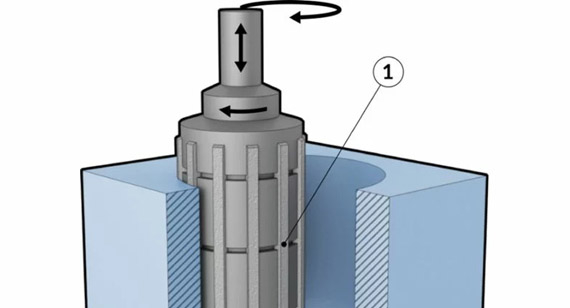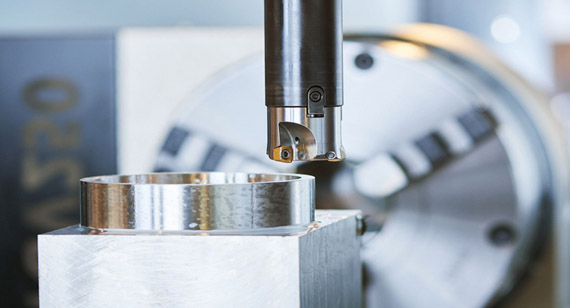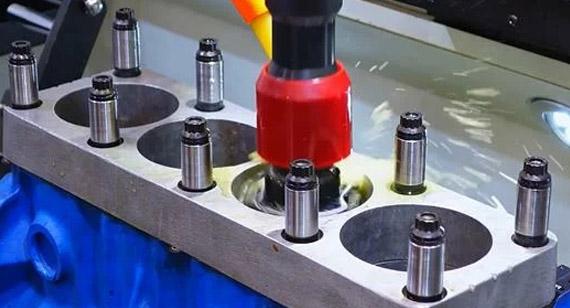15 years one-stop China custom CNC machining parts factory
 1280 |
Published by VMT at Sep 18 2024
1280 |
Published by VMT at Sep 18 2024
In the field of CNC machining, honing is a finishing process designed to improve the geometry, size, and surface finish of a part. By removing a small amount of material using an abrasive tool, honing ensures that machined parts meet precise specifications. This process is widely employed in manufacturing industries such as automotive, aerospace, medical, and more, particularly for parts where high precision and surface quality are critical.
The honing process complements CNC machining services, playing a crucial role in refining parts after primary machining processes. This article will explore the definition of honing, its different types, the operation involved, and the purposes it serves in modern manufacturing.
Honing is a precision machining process that uses a rotating tool, typically equipped with abrasive stones, to improve the dimensional accuracy and surface finish of a component. This process is often used on internal cylindrical surfaces, like bores, to ensure they are smooth, round, and of the desired size. The tool rotates and moves reciprocally, engaging with the workpiece to remove fine amounts of material. As a result, honing is frequently used in parts like engine cylinders, hydraulic cylinders, and bearings, where precision is essential.
In custom CNC machining, honing ensures parts meet strict tolerances, particularly in terms of roundness, straightness, and smoothness. This finishing step is particularly important for CNC prototype machining and high-precision applications where surface imperfections can affect the part's performance and lifespan.

Honing offers several advantages in the manufacturing process, especially for industries where precision and reliability are crucial. There are four main reasons for honing parts after CNC machining:
Improve Accuracy
Honing allows manufacturers to achieve superior accuracy compared to other machining processes. By refining the bore diameter, roundness, and surface finish, honing improves the overall geometry of a part. It ensures that the part's dimensions are within tight tolerances, often down to microns. This accuracy is critical in industries like automotive and aerospace, where even slight variations can affect performance.
Versatility and Compatibility
Honing is versatile, capable of working with different materials such as steel, aluminum, and ceramics. It is also compatible with various CNC machined parts, whether they are small prototype pieces or mass-produced components. The process can be customized depending on the material, surface finish requirements, and tolerances needed.
Faster and More Efficient Production
When applied to high-volume CNC machining services, honing offers a fast and efficient way to achieve desired surface finishes and dimensions. The process is particularly effective when combined with other machining methods, reducing the need for additional finishing steps. This makes honing an important part of faster production cycles, particularly in industries that demand high-quality parts at scale.
Ensure Safety
Parts like automotive cylinders, hydraulic systems, and medical components must operate safely under extreme conditions. Honing helps eliminate surface irregularities that could cause wear, failure, or friction during use. By creating smooth surfaces, honing ensures that components work reliably and safely throughout their service life.
A single-pass honing machine is a specialized tool used in high-production environments where speed and efficiency are crucial. Unlike traditional honing methods, which require multiple passes to achieve the desired finish, single-pass honing machines use a fixed-diameter abrasive tool that passes through the workpiece once, producing a finished surface in a single operation.
This type of honing machine is particularly useful for small-diameter components, typically up to 2 inches in size. It offers high production efficiency, reducing the cost per part and minimizing downtime associated with tool changes. Single-pass honing machines are commonly used in applications that require repeatable accuracy for features like bore diameter, roundness, and surface finish.
In single-pass honing, superabrasives like diamond and cubic boron nitride (CBN) are used, ensuring the process can remove material quickly and effectively. A high volume of coolant, usually oil-based, is necessary to continuously flush away debris from the honing area, ensuring the surface remains clean and free from imperfections.

Single-pass honing tools are ideal for high-volume production runs, particularly in industries where precision, speed, and cost-efficiency are key. Here are the specific conditions where single-pass honing tools are advantageous:
Small Diameter Honing Machines: When dealing with small bore diameters, single-pass tools offer quick and precise results. These machines are commonly used for parts with diameters up to 2 inches.
High Production: When large quantities of CNC machined parts need to be finished efficiently, single-pass honing machines provide a faster alternative to traditional multi-pass methods.
Lower Cost Per Part: The reduction in cycle time and tooling costs leads to a lower cost per part, making single-pass honing a cost-effective solution for mass production.
Reduced Downtime: Since single-pass honing tools don’t require frequent tool changes, they minimize downtime, ensuring smooth and continuous production.
Repeatable Accuracy: Single-pass honing is ideal when dimensional tolerances must be highly consistent across a large production run, ensuring parts like bore diameter and roundness meet exact specifications.
Honing operations can be broadly classified into two types: mechanical and manual.
Mechanical Honing Operations
Mechanical honing uses automated equipment that moves the honing tool through the part, allowing for greater precision and consistency. It is commonly used in CNC machining factories, where accuracy and efficiency are paramount. Machines can be set to exact specifications, ensuring that each part meets the same high-quality standard.
Manual Honing Operations
Manual honing is a more traditional approach, where the operator controls the honing tool. While it allows for flexibility in adjusting pressure and speed, manual honing is more time-consuming and less precise than mechanical operations. This method is typically reserved for smaller batches or specialized components that require custom finishes.
Different Honing Machines
Honing machines are typically categorized into two main types: horizontal and vertical honing machines.
Horizontal Honing Machines
Horizontal machines are suited for parts with longer bores or components that require honing in a horizontal orientation. These machines are widely used in the automotive industry for finishing engine cylinders and similar components.
Vertical Honing Machines
Vertical machines are designed for shorter parts or components that are easier to hone in a vertical position. These machines offer high levels of precision and are often used for finishing small, high-precision parts in industries like medical device manufacturing.
Several tools are used in honing operations to ensure accuracy and surface finish quality.
Whetstones
Whetstones are abrasive stones used in honing to smooth and polish surfaces. Depending on the material and application, different types of honing stones can be used. Common varieties include diamond honing stones, which offer excellent durability, and silicon carbide stones, which are effective for softer materials.
Honing Spindles
The honing spindle holds the abrasive stones and rotates them against the workpiece. The precision of the spindle determines the overall accuracy of the honing process.
Honing Oils
Honing oils are essential for reducing friction and removing debris during the honing process. Both oil-based and water-based coolants can be used, although oil-based coolants are more common due to their superior lubrication properties.
Honing is an essential finishing process in a wide range of industries:
Automotive Industry: Used for finishing engine cylinders, brake components, and hydraulic systems.
Aerospace Industry: Ensures that aircraft components meet stringent tolerance and surface finish requirements.
Mold Manufacturing: Honing is used to refine mold surfaces, ensuring that finished products are smooth and defect-free.
Medical Industry: High-precision components such as surgical instruments and implants benefit from honing for accuracy and smooth surfaces.
Although honing and grinding are both material removal processes, they differ in several key areas:

Mode of Operation: Grinding uses an abrasive wheel, while honing uses a set of abrasive stones.
Amount of Material Removed: Grinding removes more material, making it better for shaping, while honing removes finer amounts to improve surface finish.
Accuracy: Honing offers superior dimensional accuracy, making it ideal for finishing processes.
Process Technology: Honing involves reciprocating motion, while grinding typically uses a rotary motion.
Honing is a critical finishing process in CNC machining, providing precision and enhancing the performance of machined parts. Whether used for automotive, aerospace, or medical components, honing ensures that parts meet strict dimensional and surface quality standards. From improving accuracy to reducing production times, honing plays an essential role in modern manufacturing.

Why choose honing over other holemaking processes?
Honing offers superior accuracy and surface finish compared to other processes like drilling or boring.
Which honing tool is best?
The choice depends on the material and application. Diamond honing stones are best for hard materials, while silicon carbide stones work well with softer metals.
Are there any limitations to honing?
Yes, honing is typically limited to finishing internal cylindrical surfaces and may not be suitable for all geometries.
Is honing the same as grinding?
No, honing is a finishing process focused on improving surface finish and accuracy, while grinding is a more aggressive material removal process.
How much material can be removed by honing?
Typically, honing removes very small amounts of material, often less than 0.01mm.
What problems can be corrected by honing?
Honing can correct surface finish issues, bore roundness, and dimensional inaccuracies.
What is the difference between honing tools and sharpening tools?
Honing tools are designed for surface finishing, while sharpening tools are used to restore cutting edges.
